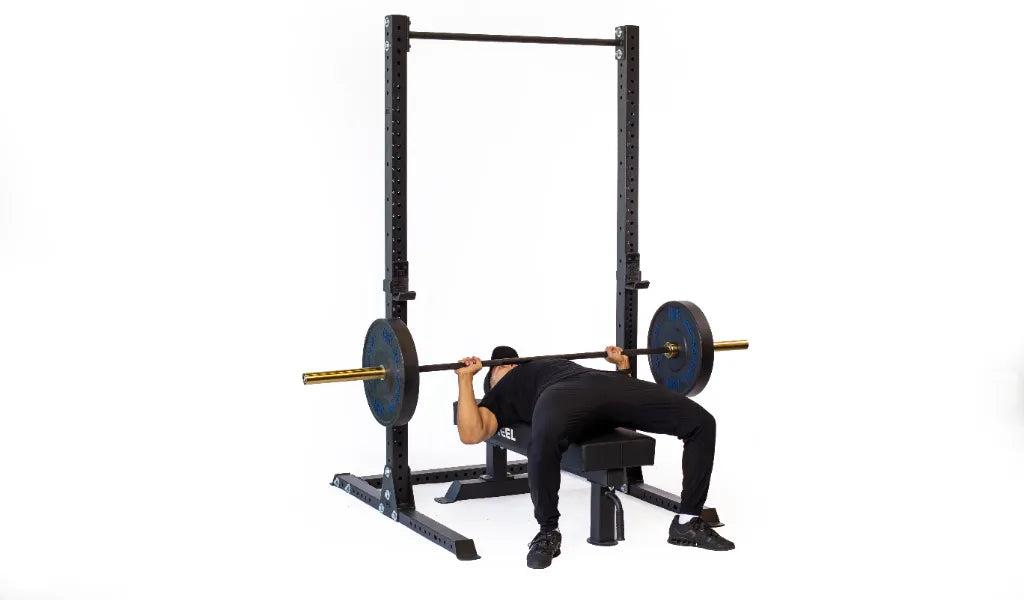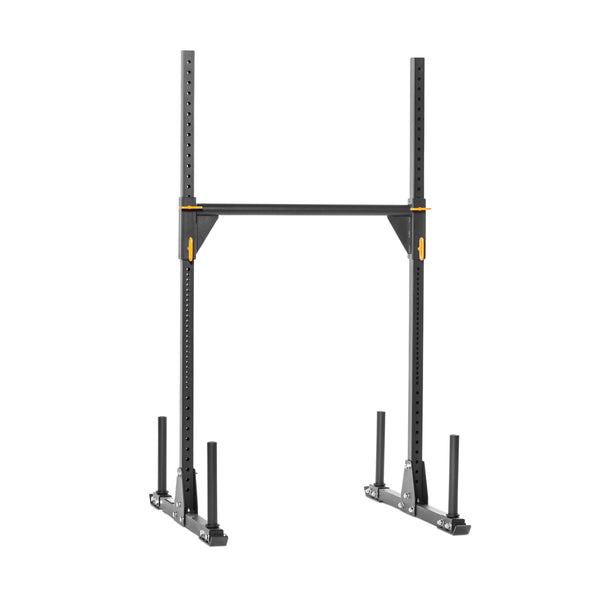Hey there, fellow iron enthusiast! If you're a proud owner of a home gym, you know that space is at a premium.
That's why squat stands have become all the rage—they offer a versatile solution for performing squats and other compound exercises without the bulk of a full power rack.
But here's the million-dollar question: can you bench on a squat stand?
Let's dive into the nitty-gritty of squat stands, safety concerns, and whether they can replace the mighty power rack. First things first, let's address the elephant in the home gym—squat stands are awesome for squats (hence the name), but can they handle the bench press? The short answer is yes, but with a few important caveats. There are a few common concerns home gym heroes experience when scouting out a squat stand for bench pressing. Here are a few we hear:
1. Stability Issues
Traditional squat stands, unlike power racks, are not as inherently stable. They lack the safety pins and additional support that power racks offer. When benching, especially heavy weights, stability is paramount.
Our Hydra Squat Stand solves these problems with a crossmember along the bottom to keep things secure, and a pull-up bar along the top to keep things locked and loaded. Bolt this bad boy down and it’s going nowhere.
2. Spotter Required
Without the safety features of a power rack, having a reliable spotter becomes crucial. You don't want to be trapped under a barbell sans assistance.
The Hydra Squat Stand has spotter arms that double as a bench station and protect that pretty face while you lift. Use them!
3. Weight Limitations
Squat stands come in various shapes and sizes, and their weight capacities vary. Before attempting to bench on one, make sure your squat stand can handle the weight you plan to lift.
The Hydra Squat Stand has a burly 1,000lb max capacity when bolted down. If your bench is over 1,000 lbs… please tag us on Instagram.
4. Safety Accessories
Some lifters prefer pin pipe safeties or safety straps over spotter arms. We can’t solve that on a squat rack, but the spotter arms are pretty robust.Okay, now that we've acknowledged the challenges, let's talk about how you can make your squat stand a safer benching platform:
1. Face Savers
Have you ever heard bench safeties referred to as “face savers?” Invest in squat stands that offer spotter arms. These accessories can save you from a potential disaster by catching the barbell if you can't lift it off your chest.
2. Weight Limit Knowledge
Know your equipment's weight limit. If your squat stand is rated for, say, 500 pounds, don't attempt to bench 600 pounds on it. Respect the limits.
3. Reliable Spotter
Enlist a reliable workout buddy as your spotter. Having someone there to assist and watch your form can make all the difference.
4. Flat Bench
Use a flat bench rather than a basic adjustable one. This ensures a more stable setup for benching on a squat stand. If you’re going the adjustable bench route, choose one that’s thick, beefy, and stable, like the FID Bench. Now, let's tackle the big question: can a squat stand replace a power rack entirely?
It ultimately depends on your needs and the squat stand you choose. Squat stands have their own charm and offer several benefits, especially for those with specific needs or space constraints.
Here's a quick rundown of the pros that squat stands hold over power racks:
Space Efficiency
Squat stands are incredibly space-efficient, making them a perfect fit for home gyms with limited room. They take up significantly less floor space compared to power racks, allowing you to maximize your workout area.
Portability
Squat stands are relatively lightweight (compared to a power rack) and easy to move around. If you need to clear space for other activities or rearrange your gym setup frequently, squat stands are a breeze to handle.
Budget-Friendly
For those on a tight budget, squat stands are usually more wallet-friendly than power racks. You can get a robust and versatile setup without breaking the bank.
Versatility
While power racks offer more attachment options, squat stands are still versatile and can accommodate various exercises. Squats, overhead presses, pull-ups, and bench presses are just a few examples of what you can do on a squat stand. Throw in a few attachments and you’ve got yourself an absolute gem!
Minimalistic Design
Squat stands have a simple and sleek design. If you prefer a clean and minimalist look for your home gym, squat stands fit the bill perfectly.
Quick Adjustments
Setting up a squat stand for different exercises is often quicker and easier than adjusting a power rack's safety pins and attachments. This convenience can save you valuable workout time.
Easy Maintenance
Squat stands typically have fewer moving parts than power racks, which means less maintenance and fewer things that can go wrong over time.
Solo Workouts
While having a spotter is always recommended, squat stands can be suitable for solo workouts, especially if you have safety accessories like spotter arms.
Customization
Our squat stands allow you to customize them with additional accessories like dip bars or landmine attachments, enhancing their functionality.
Focus on the Basics
Squat stands encourage a focus on fundamental compound exercises like squats, deadlifts, and bench presses. This can be beneficial for those who prioritize simplicity in their training.
1. Can I bench heavy on a squat stand?
Yes, you can bench heavy on a squat stand, but it's essential to use proper safety precautions, like spotter arms or a reliable spotter.
2. What's the weight limit for squat stands?
Weight limits vary depending on the squat stand's design and construction. Always check the manufacturer's specifications for your specific model. The Hydra Squat Stand has a 1,000lb weight limit when bolted to the floor.
3. Are squat stands suitable for beginners?
Squat stands can work for beginners, but extra caution is advised. Beginners should prioritize learning proper form and having a reliable spotter.
4. Can I use squat stands for other exercises?
Absolutely! Squat stands are versatile and can be used for various exercises like squats, overhead presses, and pull-ups.
5. Should I buy a power rack or a squat stand?
It depends on your specific needs and space constraints. If you have the room and want the ultimate in safety and versatility, a power rack is your go-to. If space is tight and budget is a concern, a squat stand can be a fantastic choice.In conclusion, benching on a squat stand is possible, but it comes with its own set of challenges and safety concerns.
To ensure a safe workout, invest in the right accessories and always prioritize safety. While squat stands offer versatility and space-saving benefits, they can't entirely replace the safety and versatility of a power rack. Choose the equipment that best aligns with your fitness goals and space constraints.
So, go ahead, bench on that squat stand, but bench responsibly, my friends!



